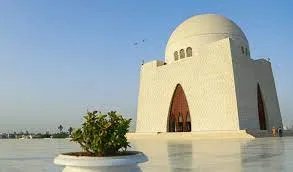
As Pakistan celebrates 76 years of its Independence Day, it’s only fitting to delve into the heart of Karachi’s most prominent landmark – the Mazar-e-Quaid, the final resting place of the nation’s founder, Quaid-e-Azam Muhammad Ali Jinnah.
This architectural marvel stands as a testament to his enduring contributions and serves as a symbol of national unity. In this blog, we’ll embark on a journey through the history, architecture, significance, and hidden treasures of this iconic mausoleum.
The proposal and construction of Mazar-e-Quaid were no small feat. After Jinnah’s passing, his resting place was marked by a simple marble slab. The Quaid-e-Azam Memorial Fund (QMF) was established in 1949 with the aim of creating a fitting memorial.
Despite several design proposals, it wasn’t until the visionary Fatima Jinnah took charge that the mausoleum’s true design began to take shape.
The mausoleum’s architectural design is a blend of contemporary and classic styles, epitomizing the modernist aesthetics of the 1960s.
The structure, designed by Indian architect Yahya Merchant, is a symbol of simplicity and power, mirroring Jinnah’s persona. The dome, standing at a remarkable height of 43 meters, ranks among the tallest domes worldwide.
The mausoleum complex boasts terraced gardens, exquisite fountains, and immaculate pathways that lead to the tomb. These elements pay homage to the nation’s Mughal heritage.
Elevated on a plinth measuring 75mx75m and standing nearly 4 meters tall, the mausoleum commands attention, highlighting its significance within the city’s landscape.
Mazar-e-Quaid holds great ceremonial importance. The grounds witness military and official ceremonies during special occasions such as Pakistan Day, Independence Day, and Quaid-e-Azam’s Birthday. Dignitaries and foreign ambassadors often pay their respects at this hallowed site.
The journey to the mausoleum’s final design involved an international competition. Interestingly, the winning design was vetoed by Fatima Jinnah, leading to a more fitting creation.
Beneath the mausoleum lies a time capsule, preserving artifacts and documents from that era for future generations.
The mausoleum’s four arched entrances feature copper latticework, allowing a symbolic and harmonious blending of cultures and communities.
Mazar-e-Quaid stands as more than just a mausoleum; it’s a beacon of unity, paying tribute to Quaid-e-Azam’s unwavering vision for Pakistan.
The serene surroundings, intricate architecture, and the resting places of other significant leaders like Liaquat Ali Khan and Fatima Jinnah make it a repository of history.
Mazar-e-Quaid is not just a place for quiet contemplation. It also serves as the epicenter of national celebrations.
From Pakistan’s Independence Day to the birth and death anniversaries of Quaid-e-Azam, this site unites people from all corners of the country to celebrate their shared history and identity.
As the flag of Pakistan waves proudly on Independence Day, the Mazar-e-Quaid stands as a testament to the visionary leader who played a pivotal role in the country’s creation. Its architecture, symbolism, and significance continue to inspire generations, reminding them of the sacrifices and ideals that form the bedrock of the nation.
Whether bathed in sunlight or illuminated by the stars, this magnificent mausoleum shines as a beacon of hope, unity, and patriotism for all Pakistanis.






























